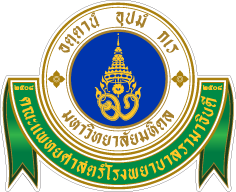
| Project Name | Pharmacogenetic Genetic Transcription Program in 1,500 volunteers from the population of Southeast Asia, South Asia, the Middle East and Southern Europe |
| Faculty/Department | Medical Genome Center, Faculty of Medicine Ramathibodi Hospital, Mahidol University |
| Background and Significance | Currently, the field of pharmacogenetics is advanced and extensively studied. However, only a small amount of findings can be applied to clinical practice. In hopes that pharmacology will help to increase drug efficacy, in addition to reducing the chance of adverse reactions at an affordable level, the Medical Genome Center aims to give patients a better quality of life in developing countries. The development of cost-effective analysis in pharmacogenetics can be applied within the Southeast Asian and Southern European regions is essential and beneficial. Such regions have patients who are at a similar risk of experiencing failed treatment, due to the risk of adverse reactions or no response to treatments administered. As such, pharmacogenetics offers an opportunity for choosing the right treatment, as such processes can be difficult, as certain treatments may be too costly, or are not effective in each circumstance, leading to an increased amount of years and savings wasted towards the treatment of non-communicable diseases. Research teams both at home and abroad have discovered that pharmacogenetic indicators can predict the risk of severe drug-induced rashes, ranking 10th in negative side-effects from the use of medication in Thailand. However, further information on drugs and their pharmacogenetic factors is limited, making it impossible to analyze data for clinical application. |
| Scope and Area of Study | Southeast Asia, South Asia, the Middle East, and Southern Europe |
| Purpose | 1. For evaluating the use of pharmacogenetic kits in the Southeast Asian region, including the population in Thailand, Singapore, Malaysia, Indonesia, Brunei, Vietnam, Laos, Myanmar, the Philippines, Cambonia; in addition to Nepal, Bhutan, Greece, and the United Arab Emirates. |
| 2. To identify and compare genetic diversity and pharmacogenetic factors related to drug efficacy, in addition to adverse reactions to drugs, including absorption, dispersion, metabolites, elimination, and drug toxcitity, between the populations of Southeast Asia, data from central databases such as Hapmap, and 1000 Genomes, in addition to the population of Nepal, Bhutan, Greece, and the United Arab Emirates. | |
| 3. To create a Pharmacogenetic Diversity Database for Southeast Asian populations, including the population of Nepal, Bhutan, Greece, and the United Arab Emirates. | |
| 4. To develop models and practice guidelines for clinical application of pharmacogenetics in Southeast Asia, in conjunction to standards and practices used in the United States of America and Europe, flexible to each country in use. | |
| Sponsors | - |
| Participants | 1.YARSI University, Jakarta, Indonesia |
| 2. RIKEN Center for Integrative Medical Sciences, Yokohama, Japan | |
| 3. School of Biotechnology, International University, Vietnam National University at Ho Chi Minh City, Vietnam | |
| 4. Medical Research Centre, Nay Pyi Taw, Myanmar | |
| 5. International University, Vietnam National University at Ho Chi Minh City, Vietnam | |
| 6. National Center for Laboratory and Epidemiology, Vientiane, Laos | |
| 7. Faculty of Medicine, University of Malaya, Kuala Lumpur, Malaysia | |
| 8. College of Pharmacy, University of the Philippines Manila, Manila, Philippines | |
| 9. Institute of Health Sciences, Universiti Brunei Darussalam, Bandar Seri Begawan, Brunei Darussalam | |
| 10. Genome Institute of Singapore, Agency for Science, Technology and Research, Singapore, Singapore | |
| 11. Kathmandu Medical College Teaching Hospital, Kathmandu, Nepal | |
| 12. Department of Pathology, United Arab Emirates University, United Arab Emirates | |
| 13. Pharmacogenomics and Pharmaceutical Biotechnology, University of Patras, Greece | |
| 14. Department of Medical Sciences, Ministry of Public Health | |
| 15. Princess Chulabhorn College of Medical Sciences, Thailand | |
| Stakeholders | 1.YARSI University, Jakarta, Indonesia |
| 2. RIKEN Center for Integrative Medical Sciences, Yokohama, Japan | |
| 3. School of Biotechnology, International University, Vietnam National University at Ho Chi Minh City, Vietnam | |
| 4. Medical Research Centre, Nay Pyi Taw, Myanmar | |
| 5. International University, Vietnam National University at Ho Chi Minh City, Vietnam | |
| 6. National Center for Laboratory and Epidemiology, Vientiane, Laos | |
| 7. Faculty of Medicine, University of Malaya, Kuala Lumpur, Malaysia | |
| 8. College of Pharmacy, University of the Philippines Manila, Manila, Philippines | |
| 9. Institute of Health Sciences, Universiti Brunei Darussalam, Bandar Seri Begawan, Brunei Darussalam | |
| 10. Genome Institute of Singapore, Agency for Science, Technology and Research, Singapore, Singapore | |
| 11. Kathmandu Medical College Teaching Hospital, Kathmandu, Nepal | |
| 12. Department of Pathology, United Arab Emirates University, United Arab Emirates | |
| 13. Pharmacogenomics and Pharmaceutical Biotechnology, University of Patras, Greece | |
| 14. Department of Medical Sciences, Ministry of Public Health | |
| 15. HRH Princess Chulabhorn College of Medical Sciences, Thailand | |
| Level of Cooperation and Participation | International |
| Results for Further Use | The development of the Pharmacogenetic Diversity Database for Southeast Asian populations, including the population of Nepal, Bhutan, Greece, and the United Arab Emirates for the purpose of creating possibilities for effective, safe, and cost-effective treatment for patients within the regions. |
| Related Links | https://med.mahidol.ac.th/genomics/th/aboutus |
| Related Sustainable Development Goals (SDGs) | - |



